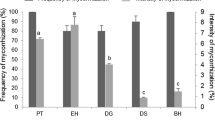Summary
Actinorhizal root nodules ofGymnostoma papuanuum (Casuarinaceae) were examined with transmission electron microscopy after being either fixed with glutalaldehyde and osmium tetroxide or frozen with liquid nitrogen at high pressure and freeze-substituted. Much better preservation was obtained by the cryopreservation method. Mitochondria, plastids, membranes und ribosomes were much better preserved in the frozen specimens than in the chemically fixed tissues. No nucleoids were observed in the microsymbiont in frozen specimens. In contrast nucleoid regions were present in chemically fixed specimens. The actinomycete microsymbiont differentiates small spherical-shaped symbiotic vesicles after the hyphae have grown and penetrated into most regions of the cytoplasm.
Similar content being viewed by others
References
Abeysekera RM, Newcomb W, Silvester WB, Torrey JG (1990) A freeze-fracture electron microscopic study ofFrankia in root nodules ofAlnus incana grown at three oxygen tensions. Can J Microbiol 36: 97–108
Bajer A, Mole-Bajer J (1971) Architecture and function of the mitotic spindle. Adv Cell Mol Biol 1: 213–266
— — (1969) Formation of spindle fibers, kinetochore orientation, and behavior of the nuclear envelope during mitosis in endosperm. Fine structural andin vitro studies. Chromosoma 27: 448–484
Berg RH, Mc Dowell L (1987) Endophyte differentiation inCasuarina actinorhizae. Protoplasma 136: 104–117
Gilkey JC, Staehelin A (1986) Advances in ultrarapid freezing for the preservation of cellular ultrastructure. J Electron Microsc Tech 3: 177–210
Heath IB (1984) A simple and inexpensive liquid helium cooled ”slam freezing” device. J Microsc 135: 75–82
Heuser JD, Reese TS, Landris DMD (1976) Preservation of synaptic structure by rapid freezing. Cold Spring Harbor Symp Quant Biol 40: 17–24
Lancelle S, Torrey JG, Hepler PK, Callaham DA (1985) Ultrastructure of freeze-substitutedFrankia strain HFPCcI3, the actinomycete isolated from root nodules ofCasuarina cunninghamina. Protoplasma 127: 64–72
Meesters TM (1987) Localization of nitrogenase in vesicles ofFrankia sp. Ccl. 17, by immunogold labelling techniques. Arch Microbiol 146: 327–331
—, Van Vliet WM, Akkermans ADL (1987) Nitrogenase is restricted to the vesicles inFrankia strain EANlpec. Physiol Plant 70: 267–271
Mersey B, McCully ME (1978) Monitoring of the course of fixation of plant cells. J Microsc 114: 49–76
National Research Council (1984) Casuarinas: nitrogen-fixing trees for adverse sites. National Academy Press, Washington, DC
Newcomb W, Wood SM (1987) Morphogenesis and fine structure ofFrankia (Actinomycetales): the microsymbiont of nitrogenfixing root nodules. Int Rev Cytol 109: 1–88
—, Baker D, Torrey JG (1987) Ontogeny and fine structure of effective root nodules of the autumn olive (Elaeagnus umbellata). Can J Bot 65: 80–94
Noridge NA, Benson DR (1986) Isolation and nitrogen-fixing activity ofFrankia spp. strain CpIl vesicles. J Bacteriol 166: 301–305
Racette S, Torrey JG (1989 a) The isolation, culture and infectivity of aFrankia strain fromGymnostoma papuanum (Casuarinaceae). Plant Soil 118: 165–170
— — (1989 b) Root nodule initiation inGymnostoma (Casuarinaceae) andShepherdia (Elaeagnaceae) induced byFrankia strain HFPGpIl. Can J Bot 66: 2873–2879
Sabatini DD, Bensch K, Barrnett RJ (1963) Cytochemistry and electron microscopy. The preservation of cellular ultrastructure and enzymatic activity by aldehyde fixation. J Cell Biol 17: 19–58
Sasakawa H, Hiyoshi T, Sugiyama T (1988) Immuno-gold localization of nitrogenase in root nodules ofElaeagnus pungens Thunb. Plant Cell Physiol 29: 1147–1152
Silvester WB, Whitlock J, Silvester JK, Torrey JG (1988) Growth, nodule morphology, and nitrogenase activity ofMyrica gale with roots grown at various oxygen levels. Can J Bot 66: 1762–1771
Wood SM, Newcomb W, Nelson D (1989) Fine structure of the microsymbiont of the actinorhizal root nodules of mountain mahogany (Cercocarpus ledifolius, family Rosaceae). Can J Bot 67: 116–120
Author information
Authors and Affiliations
Additional information
Dedicated to the memory of Professor Oswald Kiermayer
Rights and permissions
About this article
Cite this article
Newcomb, W., Jackson, S., Racette, S. et al. Ultrastructure of infected cells in the actinorhizal root nodules ofGymnostoma papuanum (Casuarinaceae) prepared by high pressure freezing and chemical fixation. Protoplasma 157, 172–181 (1990). https://doi.org/10.1007/BF01322650
Received:
Accepted:
Issue Date:
DOI: https://doi.org/10.1007/BF01322650




